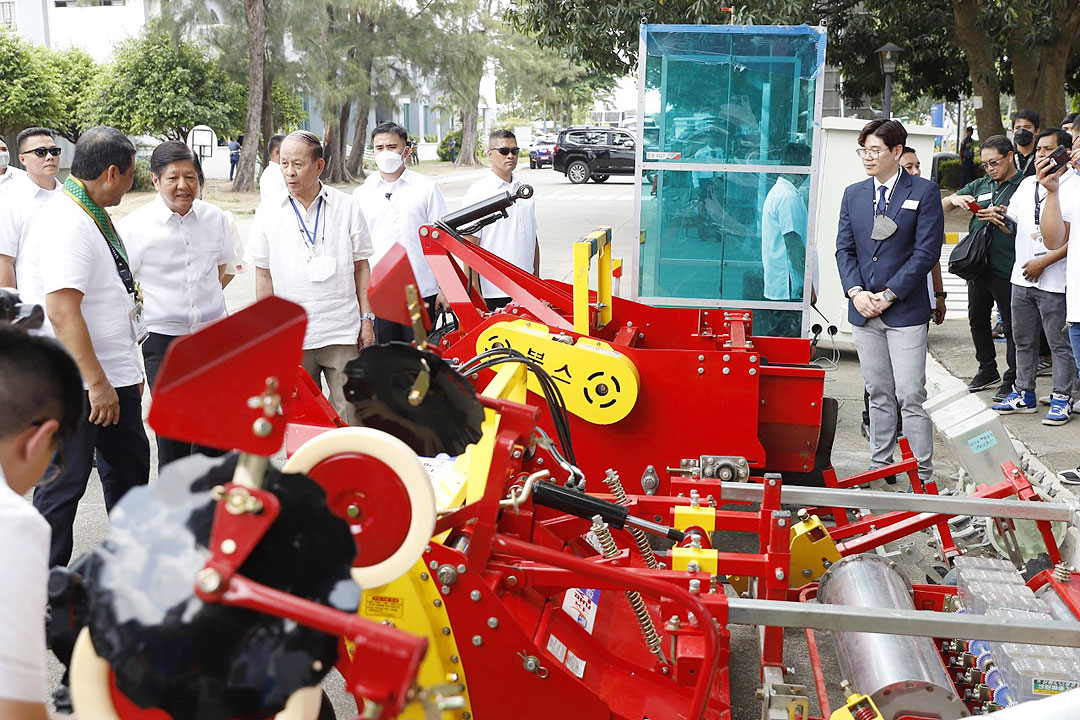Marcos vows to boost local production of farm machines

PRESIDENT Ferdinand R. Marcos, Jr. on Monday vowed to boost the Philippines’ capability to manufacture its own farm machines as part of improving agricultural production and achieving food self sufficiency.
He cited strides made by the Philippine Center for Postharvest Development and Mechanization (PhilMech) in collaboration with foreign partners.
PhilMech, he said has locally manufactured machines for planting, cultivation, harvesting, and post-production.
“If you see the machineries displayed outside, so we can manufacture our own so that we don’t have to rely on importation,” he said in Filipino during the distribution of agriculture assistance in Central Luzon State University in Nueva Ecija, based on a press release from the Presidential Communications Office (PCO).
The government is also looking at improving research and development to increase agricultural productivity, Mr. Marcos Jr. said.
“Central Luzon has been an important region for agricultural production with its 552,105 hectares (ha) of land area devoted to agriculture,” the PCO said. [Text Wrapping Break]
“More than 80 percent of the region’s land area (463,398 ha) is devoted to rice farming.”
The region has an average annual rice production of 3.66 million metric tons for the 2020-2022 period.
KADIWA STORES
Meanwhile, Mr. Marcos said state-assisted farm-to-consumer stores will remain an important component of the government’s agriculture program.
Mr. Marcos wants to establish more Kadiwa centers in the country “to help local producers earn a higher income by eliminating intermediaries and, at the same time, allow consumers to buy agricultural products and other goods at a lower price,” the PCO said in a separate statement, citing the President’s interview with broadcaster and former Social Welfare Secretary Erwin T. Tulfo.
The President said at the interview that aside from expanding Kadiwa outlets across the country, he also intends to lower food prices in local markets.
There are now 300 Kadiwa centers nationwide, the PCO said.
Kadiwa stores are government-supported shops promising lower prices because of their farm-to-consumer distribution model and subsidized transport.
Last year, Kadiwa stores only reached 1.2 million out of over 25 million households, “or not even 6% of the total,” said Jose Enrique “Sonny” A. Africa, executive director of think tank IBON Foundation.
“The small number of families helped is a strong indicator that the Kadiwa effort is more of a propaganda device than genuine support for Filipino consumers struggling with high prices,” he said in a Facebook Messenger chat.
In March, Mr. Marcos Jr. claimed that his administration was making gradual progress in fulfilling his campaign promise of bringing the price of rice down to P20 per kilogram.
On the other hand, the Department of Agriculture earlier this month said retail prices of rice would likely increase by as much as P5 a kilo.
“As of now, we are seeing an increase of up to P5 per kilo in rice. If wholesale prices continue to rise, definitely prices in the retail markets will increase. If the farm-gate price (of unhusked rice) goes up, that will translate to higher selling prices for rice,” Agriculture Assistant Secretary Rex C. Estoperez said.
He said low buffer stock, higher prices of unhusked rice, and expensive farm inputs are among the major factors behind the expected price increase.
Mr. Estoperez said he was puzzled why rice inventories have declined despite the increase in rice imports last year. “We are also wondering why, because we had imports of 3.8 million metric tons last year. What happened to those stocks?”
In January, Mr. Marcos Jr. signed an executive order extending lower import tariffs on rice and corn and other agriculture products. — Kyle Aristophere T. Atienza



